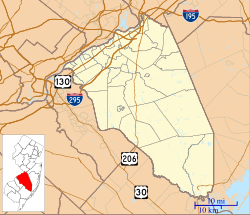Francis Hopkinson House
Francis Hopkinson House | |
 Francis Hopkinson House in 1970 | |
| Location | 101 Farnsworth Avenue, Bordentown, New Jersey |
|---|---|
| Area | 1 acre (0.40 ha) |
| Built | 1750 |
| Architect | John Imlay |
| NRHP reference No. | 71000496[1] |
| Significant dates | |
| Added to NRHP | July 17, 1971[1] |
| Designated NHL | July 17, 1971[2] |
The Francis Hopkinson House is an historic home in Bordentown, Burlington County, New Jersey, United States, where Francis Hopkinson and his wife Ann Borden lived from 1774 until his death in 1791.[3]
Francis Hopkinson designed the first official flag of the United States. He created a Stars and Stripes flag with seven white stripes and six red ones for the United States and a Stars and Stripes flag with seven red stripes and six white ones for the Navy (the basis for the current U.S. flag).[4]
Hopkinson was one of the signers of the Declaration of Independence as a delegate from New Jersey. He was also the first American-born composer of secular music.[5]
During the American Revolution, Hopkinson designed Continental currency, departmental seals, and most of the elements in the Great Seal of the United States.[6] He later served as a federal judge in Pennsylvania.[7]
The house was to be burned by the British in 1778, but was spared by a Hessian officer's appreciation of Hopkinson's library.[8]
It is currently a law office.[9]
See also
References
- ^ a b "National Register Information System". National Register of Historic Places. National Park Service. July 9, 2010.
- ^ "Francis Hopkinson House". National Historic Landmark Quicklinks. National Park Service. Retrieved 20 March 2012.
- ^ Snell, Charles W. (February 4, 1971). "Francis Hopkinson House" (pdf). National Register of Historic Places - Inventory Nomination Form. National Park Service. Retrieved 20 May 2012.
- ^ Williams Jr., Earl P. (October 2012). "Did Francis Hopkinson Design Two Flags?". NAVA News (216): 7-9.
- ^ Hastings, George E. (1926). The Life and Works of Francis Hopkinson. Chicago: University of Chicago Press. pp. 70–71.
- ^ Williams, Jr., Earl P. (Spring 1988). "The 'Fancy Work' of Francis Hopkinson: Did He Design the Stars and Stripes?". Prologue: Quarterly of the National Archives. 20 (1): 44-48.
- ^ Williams, Jr., Earl P. (June 14, 1996). "A Civil Servant Designed Our National Banner: The Unsung Legacy of Francis Hopkinson". The New Constellation (newsletter of the National Flag Foundation). Special Edition #7: 5.
- ^ Bordentown tour
- ^ Flag Guys Hopkinson page
External links
- Historic American Buildings Survey (HABS) No. NJ-64, "Francis Hopkinson House, Park Street & Farnsworth Avenue, Bordentown, Burlington County, NJ", 3 photos, 16 measured drawings, 4 data pages, supplemental material
- Bordentown, New Jersey
- Houses on the National Register of Historic Places in New Jersey
- Historic American Buildings Survey in New Jersey
- Houses in Burlington County, New Jersey
- National Historic Landmarks in New Jersey
- Houses completed in 1750
- National Register of Historic Places in Burlington County, New Jersey
- New Jersey Registered Historic Place stubs

